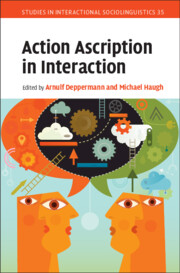Book contents
- Action Ascription in Interaction
- Studies in Interactional Sociolinguistics
- Action Ascription in Interaction
- Copyright page
- Contents
- Figures
- Tables
- Contributors
- Introduction
- Part I Constituents of Action Ascription
- Part II Practices of Action Ascription
- 6 Intention Ascriptions as a Means to Coordinate Own Actions with Others’ Actions
- 7 Strategy Ascriptions in Public Mediation Talks
- 8 Action Ascription and Deonticity in Everyday Advice-Giving Sequences
- 9 “How about Eggs?”
- 10 Action Ascription and Action Assessment
- 11 Actions and Identities in Emergency Calls
- Part III Revisiting Action Ascription
- Book part
- Index
- References
8 - Action Ascription and Deonticity in Everyday Advice-Giving Sequences
from Part II - Practices of Action Ascription
Published online by Cambridge University Press: 17 February 2022
- Action Ascription in Interaction
- Studies in Interactional Sociolinguistics
- Action Ascription in Interaction
- Copyright page
- Contents
- Figures
- Tables
- Contributors
- Introduction
- Part I Constituents of Action Ascription
- Part II Practices of Action Ascription
- 6 Intention Ascriptions as a Means to Coordinate Own Actions with Others’ Actions
- 7 Strategy Ascriptions in Public Mediation Talks
- 8 Action Ascription and Deonticity in Everyday Advice-Giving Sequences
- 9 “How about Eggs?”
- 10 Action Ascription and Action Assessment
- 11 Actions and Identities in Emergency Calls
- Part III Revisiting Action Ascription
- Book part
- Index
- References
Summary
This chapter addresses action ascription in everyday advice-giving sequences, with a focus on those sequences in which advice has not been solicited as such. We argue that for action ascription in both second and third positions, the design (‘composition’) and the sequential location (‘position’) of the prior turn are crucial. Advice-giving typically emerges in the environment of a complaint or troubles-telling; in second position, the recipient must then decide whether or not it warrants advice. In third position, the recipient of a piece of advice must decide how exactly it was meant: as a binding prescription or injunction, or as a mild suggestion for a possible way forward? This is relevant for the advice-recipient in deciding how to deal with the advice: whether to accept or reject/resist it, or to join the other in brainstorming about how to remedy the situation. Relatively strong deontic formats position advice-givers as experts who know best what their interlocutor ‘needs’, and tend to be resisted; weaker formats call on the recipient not so much to accept or reject the advice given as to acknowledge or agree that the action in question would be a possible course of action with beneficial effects.
- Type
- Chapter
- Information
- Action Ascription in Interaction , pp. 183 - 207Publisher: Cambridge University PressPrint publication year: 2022
References
- 11
- Cited by

